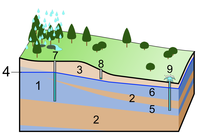
Photo from wikipedia
Abstract Undesirable water production due to water coning in hydrocarbon reservoirs has been a long-standing issue. This phenomenon decreases the oil production rate, increases the water cut and ultimately leads… Click to show full abstract
Abstract Undesirable water production due to water coning in hydrocarbon reservoirs has been a long-standing issue. This phenomenon decreases the oil production rate, increases the water cut and ultimately leads to early well-shutdown. Water coning may also interrupt the well testing data acquisition used to determine the reservoir permeability. In this study, attempts are made to propose a new approach which can control the water coning and estimate the reservoir permeability simultaneously. This was done by proposing a new boundary control model that was coupled by the Ensemble Kalman Filter (EnKF). A synthetic case study was considered to evaluate the performance of the EnKF associated boundary control (EnKF-ABC) approach. The results obtained indicated that the water cone development is controlled by the proposed method. In addition, the proposed method was also successful to estimate the reservoir permeability in the presence of water cone with less than 20% error after 12 times of downhole data acquisition. Even in the worst case scenario where there was a significant uncertainty in the initial estimated permeability, all the permeability ensemble members converged after about 200 days and tended to the real permeability after 500 days with less than 5% error. It was also observed that the Root Mean Squared Error (RMSE) of permeability sharply decreases when the ensemble size exceeds 15. The proposed approach is robust and reliable even where the mean of initial estimated permeability is considered quite far from the actual one. The EnKF-ABC approach proposed in this study can be applied to those production wells that suffer from water coning and there is lack of prior knowledge about the reservoir permeability.
Journal Title: Journal of Petroleum Science and Engineering
Year Published: 2021
Link to full text (if available)
Share on Social Media: Sign Up to like & get
recommendations!